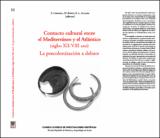Por favor, use este identificador para citar o enlazar a este item:
http://hdl.handle.net/10261/32927COMPARTIR / EXPORTAR:
 SHARE
BASE SHARE
BASE
|
|
| Visualizar otros formatos: MARC | Dublin Core | RDF | ORE | MODS | METS | DIDL | DATACITE | |

| Campo DC | Valor | Lengua/Idioma |
|---|---|---|
| dc.contributor.author | Rafel Fontanals, Nuria | - |
| dc.contributor.author | Vives-Ferrándiz, Jaime | - |
| dc.contributor.author | Armada, Xosé-Lois | - |
| dc.contributor.author | Graells i Fabregat, Raimon | - |
| dc.date.accessioned | 2011-03-01T15:20:28Z | - |
| dc.date.available | 2011-03-01T15:20:28Z | - |
| dc.date.issued | 2008 | - |
| dc.identifier.citation | En S. Celestino, N. Rafel, X.-L. Armada (eds.), Contacto cultural entre el Mediterráneo y el Atlántico (siglos XII-VIII ane). La precolonización a debate: 239-271. Madrid. | es_ES |
| dc.identifier.isbn | 978-84-00-08689-3 | - |
| dc.identifier.other | NIPO 653-08-113-3 | - |
| dc.identifier.other | Depósito Legal M.38.572-2008 | - |
| dc.identifier.uri | http://hdl.handle.net/10261/32927 | - |
| dc.description | El libro en el que es publicado este capítulo puede ser consultado en el enlace: http://hdl.handle.net/10261/32919 | es_ES |
| dc.description.abstract | [ES] | es_ES |
| dc.description.abstract | [EN] This paper assesses the characteristics and evolution of the Bronze Age communities in eastern Iberia, from the Pyrenees in the north to the river Segura valley in the south. Archaeological material of foreign origin or influence is analysed in order to consider the role of this area in pre-colonial exchanges. The Mediterranean relations of the communities on the east coast of the Iberian Peninsula were much stronger than recognised previously. The archaeological record from this area shows an uneven distribution of resources and objects, which can be equated with the social inequalities in the Late Bronze Age communities that are well attested in their burials. Some items usually linked to Phoenician trade must be dissociated from it, because the exchanges seem to have been made in other networks, including the central Mediterranean, and the focus of research on Phoenician pottery has neglected the important links shown by metal objects. It is difficult in the current state of knowledge to date some of these items accurately to either before or after the beginning of the colonial trade; and it seems clear that some bronzes from eastern Iberia, although dated to this period, were not part of the trading networks which radiated from the area of the Straits of Gibraltar, but came instead from the central Mediterranean. The Phoenician presence in Catalonia must be dated to the 8th century B.C., though in all the area between the River Vinalopó and the Ampurias region contacts peaked during the 7th century. Most studies of Phoenician trade with the east coast of Iberia have concluded that Ibiza was the only mediator for these relations, but in our opinion other routes may have co-existed. Contrary to the ex oriente lux diffusionist model, the archaeological record shows the existence of a fluid exchange network in the central and western Mediterranean, in which local communities from Iberia were not passive agents, but played an active role. For this reason, the origin of many objects often regarded as imports must be reconsidered. To conclude, a picture emerges in which the communities of eastern Iberia were clearly involved in the socio-economic dynamics and trading networks of both the Mediterranean and the Atlantic in the Late Bronze Age and the beginning of the Iron Age. These local communities were the leading agents of their own transformations before the arrival of the Phoenicians, a crucial factor in creating the conditions that made commercial relations with them possible. Characterisation of these Iberian societies during the Bronze Age, especially their exchange networks, is essential to our understanding of their responses to those exchanges and of the transformations of their social organization within the colonial framework from the 8th century onwards. | es_ES |
| dc.language.iso | spa | es_ES |
| dc.publisher | CSIC - Escuela Española de Historia y Arqueología (EEHAR) | es_ES |
| dc.rights | openAccess | es_ES |
| dc.subject | Contactos precoloniales | es_ES |
| dc.subject | Pre-colonial contacts | es_ES |
| dc.subject | Colonización fenicia | es_ES |
| dc.subject | Phoenician colonization | es_ES |
| dc.subject | Late Bronze Age | es_ES |
| dc.subject | Bronce final | es_ES |
| dc.subject | Transición Bronce Final – Edad del Hierro | es_ES |
| dc.subject | Late Bronze Age – Iron Age Transition | es_ES |
| dc.subject | Iberia mediterránea | es_ES |
| dc.subject | Mediterranean Iberia | es_ES |
| dc.subject | Comercio antiguo | es_ES |
| dc.subject | Ancient trade | es_ES |
| dc.subject | LaPa | - |
| dc.title | Las comunidades de la Edad del Bronce entre el Empordà y el Segura: espacio y tiempo de los intercambios | es_ES |
| dc.type | capítulo de libro | es_ES |
| dc.description.peerreviewed | Peer reviewed | es_ES |
| dc.type.coar | http://purl.org/coar/resource_type/c_3248 | es_ES |
| item.languageiso639-1 | es | - |
| item.fulltext | With Fulltext | - |
| item.openairecristype | http://purl.org/coar/resource_type/c_18cf | - |
| item.cerifentitytype | Publications | - |
| item.grantfulltext | open | - |
| item.openairetype | capítulo de libro | - |
| Aparece en las colecciones: | (IEGPS) Libros y partes de libros (INCIPIT) Libros y partes de libros | |
Ficheros en este ítem:
| Fichero | Descripción | Tamaño | Formato | |
|---|---|---|---|---|
| 2008_Contacto cultural_RafelVivesArmadaGraells_Las comunidades.pdf | 1,83 MB | Adobe PDF |  Visualizar/Abrir |
CORE Recommender
Page view(s)
546
checked on 22-abr-2024
Download(s)
1.584
checked on 22-abr-2024
Google ScholarTM
Check
Altmetric
NOTA: Los ítems de Digital.CSIC están protegidos por copyright, con todos los derechos reservados, a menos que se indique lo contrario.
